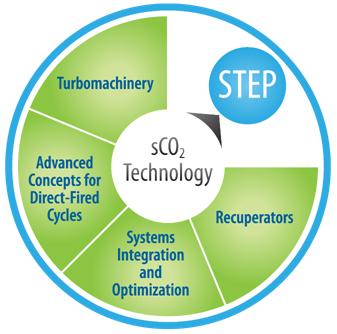
![]()
 The supercritical carbon dioxide (sCO2) power cycle operates in a manner similar to other turbine cycles, but it uses CO2 as the working fluid in the turbomachinery. The cycle is operated above the critical point of CO2 so that it does not change phases, but rather undergoes drastic density changes over small ranges of temperature and pressure. Supercritical CO2-based power cycles have shown the potential for increased heat-to-electricity conversion efficiencies, high power density, and simplicity of operation compared to existing steam-based power cycles. The sCO2 power cycle utilizes small turbomachinery, is fuel- and/or heat-source neutral, and efficient.
The supercritical carbon dioxide (sCO2) power cycle operates in a manner similar to other turbine cycles, but it uses CO2 as the working fluid in the turbomachinery. The cycle is operated above the critical point of CO2 so that it does not change phases, but rather undergoes drastic density changes over small ranges of temperature and pressure. Supercritical CO2-based power cycles have shown the potential for increased heat-to-electricity conversion efficiencies, high power density, and simplicity of operation compared to existing steam-based power cycles. The sCO2 power cycle utilizes small turbomachinery, is fuel- and/or heat-source neutral, and efficient.
The Supercritical Carbon Dioxide Technology program goal is to develop highly efficient and lower cost indirectly-heated power cycles that surpass the performance of advanced ultra-supercritical steam and provide the technology base for directly-heated power cycles using more advanced fossil energy conversion systems based on sCO2 cycles. The direct-fired cycle can facilitate carbon capture by producing a high purity stream of carbon dioxide that is ready for use/reuse or storage. For a more detailed description of these cycles, click the link below.
The Fossil Energy (FE) Base Program work to develop sCO2 cycle components is funded by individual FE programs and is coordinated with the Supercritical Transformational Electric Power (STEP) program focused on the design, build, and operation of a 10 MWe pilot plant test facility.
The sCO2 Technology supports research and development (R&D) in four key technology areas: Turbomachinery, Recuperators, Advanced Concepts for Direct-Fired Cycles, and Systems Integration & Optimization.
The turbomachinery R&D focuses on advancing technologies and designs of turbomachinery to be used in the supercritical CO2 power cycle. Operating power cycles, either directly or indirectly, with supercritical CO2 offers potential for further improvements in power cycle efficiencies and lower costs. However, the utilization of supercritical CO2 as the working fluid must be considered when designing the turbines. Extremely compact turbine sizes are possible for use in the supercritical CO2-based power cycles. These turbines will have high power density, lower peripheral speeds, high blade loading, and high shaft speeds, all of which will factor into the final turbine designs. The high pressure, relatively high temperature, uncertainty of the CO2 state near the critical point, and high power density create design challenges for the supercritical CO2 turbomachinery. The R&D will consider all aspects of the turbomachinery, including the turbo-expander, compressors, pumps, airfoils, turbine coupling with the motor/generator, seals, casings, bearings, shafts, and valves.
The supercritical CO2-based power cycle utilizes high and low temperature recuperators to recover heat in the process and increase cycle efficiency. The recuperator projects focus on the advancement of technologies and designs, along with the fabrication of recuperative heat exchangers. Work includes development and testing of innovative compact, high surface area density recuperator designs and identification of compatible materials to allow for highly efficient heat transfer under operation at high inlet temperatures and large pressure differentials typical of the supercritical CO2 power cycles. Multiple compact heat exchanger concepts will be identified, developed, and evaluated. Achieving recuperator cost and performance targets is vital to enabling commercial implementation of the sCO2 power cycle.
For directly-fired supercritical CO2 power cycles, oxygen and fuel (either syngas or natural gas) are combusted, forming a stream of primarily supercritical CO2 and steam which is used as the working fluid in the power cycle. The higher temperature and pressure conditions of these cycles give the potential for even higher cycle efficiencies, while the process produces CO2 for either sequestration or reuse purposes. The R&D within this key technology aims to develop high-pressure and high-temperature oxy-fuel combustors to be used with CO2 as the diluent, as well as the integration of the combustors with the turbomachinery, for use in directly fired sCO2 power cycles. The challenges associated with this R&D include understanding combustion kinetics and dynamics under these conditions, combustion stability, flow path design, thermal management, pressure containment, and definition of turbine inlet conditions.
The supercritical CO2 power cycle can be integrated with the fossil energy heat source in various configurations. Optimal integration and process operating conditions must be identified to achieve high efficiency and lower cost electricity generation. Systems integration and optimization work focuses on overall system analyses, modeling, and engineering to integrate and design the sCO2 power cycle for optimized performance (efficiency), cost, and operability.
Learn about the STEP pilot plant project.
